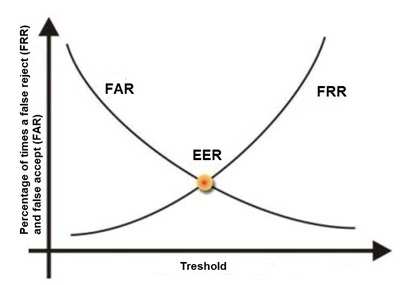When a biometric system is used, which error type deals with the possibility of GRANTING access to impostors who should be REJECTED?
A. Type I error
B. Type II error
C. Type III error
D. Crossover error
A. Type I error
B. Type II error
C. Type III error
D. Crossover error
Correct Answer: B
Explanation:
When the biometric system accepts impostors who should have been rejected , it is called a Type II error or False Acceptance Rate or False Accept Rate.
Biometrics verifies an individual’s identity by analyzing a unique personal attribute or behavior, which is one of the most effective and accurate methods of verifying identification.
Biometrics is a very sophisticated technology; thus, it is much more expensive and complex than the other types of identity verification processes. A biometric system can make authentication decisions based on an individual’s behavior, as in signature dynamics, but these can change over time and possibly be forged.
Biometric systems that base authentication decisions on physical attributes (iris, retina, fingerprint) provide more accuracy, because physical attributes typically don’t change much, absent some disfiguring injury, and are harder to impersonate.
When a biometric system rejects an authorized individual, it is called a Type I error (False Rejection Rate (FRR) or False Reject Rate (FRR)).
When the system accepts impostors who should be rejected, it is called a Type II error (False Acceptance Rate (FAR) or False Accept Rate (FAR)). Type II errors are the most dangerous and thus the most important to avoid.
The goal is to obtain low numbers for each type of error, but When comparing different biometric systems, many different variables are used, but one of the most important metrics is the crossover error rate (CER).
The accuracy of any biometric method is measured in terms of Failed Acceptance Rate (FAR) and Failed Rejection Rate (FRR). Both are expressed as percentages. The FAR is the rate at which attempts by unauthorized users are incorrectly accepted as valid. The FRR is just the opposite. It measures the rate at which authorized users are denied access.
The relationship between FRR (Type I) and FAR (Type II) is depicted in the graphic below . As one rate increases, the other decreases. The Cross-over Error Rate (CER) is sometimes considered a good indicator of the overall accuracy of a biometric system. This is the point at which the FRR and the FAR have the same value. Solutions with a lower CER are typically more accurate.
See graphic below from Biometria showing this relationship. The Cross-over Error Rate (CER) is also called the Equal Error Rate (EER), the two are synonymous.

Cross Over Error Rate
The other answers are incorrect:
Type I error is also called as False Rejection Rate where a valid user is rejected by the system. Type III error : there is no such error type in biometric system.
Crossover error rate stated in percentage , represents the point at which false rejection equals the false acceptance rate.
Reference(s) used for this question:
http://www.biometria.sk/en/principles-of-biometrics.html and Shon Harris, CISSP All In One (AIO), 6th Edition , Chapter 3, Access Control, Page 188-189 and Tech Republic, Reduce Multi_Factor Authentication Cost
Biometrics verifies an individual’s identity by analyzing a unique personal attribute or behavior, which is one of the most effective and accurate methods of verifying identification.
Biometrics is a very sophisticated technology; thus, it is much more expensive and complex than the other types of identity verification processes. A biometric system can make authentication decisions based on an individual’s behavior, as in signature dynamics, but these can change over time and possibly be forged.
Biometric systems that base authentication decisions on physical attributes (iris, retina, fingerprint) provide more accuracy, because physical attributes typically don’t change much, absent some disfiguring injury, and are harder to impersonate.
When a biometric system rejects an authorized individual, it is called a Type I error (False Rejection Rate (FRR) or False Reject Rate (FRR)).
When the system accepts impostors who should be rejected, it is called a Type II error (False Acceptance Rate (FAR) or False Accept Rate (FAR)). Type II errors are the most dangerous and thus the most important to avoid.
The goal is to obtain low numbers for each type of error, but When comparing different biometric systems, many different variables are used, but one of the most important metrics is the crossover error rate (CER).
The accuracy of any biometric method is measured in terms of Failed Acceptance Rate (FAR) and Failed Rejection Rate (FRR). Both are expressed as percentages. The FAR is the rate at which attempts by unauthorized users are incorrectly accepted as valid. The FRR is just the opposite. It measures the rate at which authorized users are denied access.
The relationship between FRR (Type I) and FAR (Type II) is depicted in the graphic below . As one rate increases, the other decreases. The Cross-over Error Rate (CER) is sometimes considered a good indicator of the overall accuracy of a biometric system. This is the point at which the FRR and the FAR have the same value. Solutions with a lower CER are typically more accurate.
See graphic below from Biometria showing this relationship. The Cross-over Error Rate (CER) is also called the Equal Error Rate (EER), the two are synonymous.

Cross Over Error Rate
The other answers are incorrect:
Type I error is also called as False Rejection Rate where a valid user is rejected by the system. Type III error : there is no such error type in biometric system.
Crossover error rate stated in percentage , represents the point at which false rejection equals the false acceptance rate.
Reference(s) used for this question:
http://www.biometria.sk/en/principles-of-biometrics.html and Shon Harris, CISSP All In One (AIO), 6th Edition , Chapter 3, Access Control, Page 188-189 and Tech Republic, Reduce Multi_Factor Authentication Cost